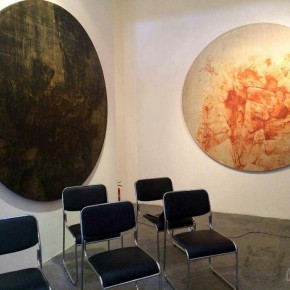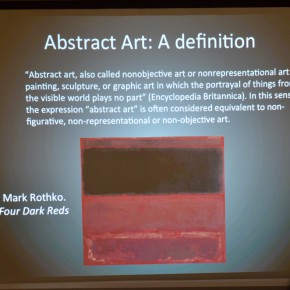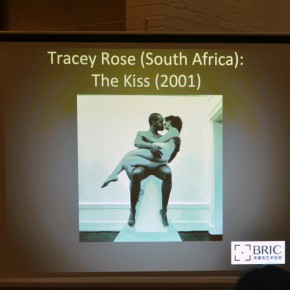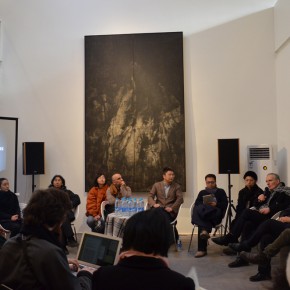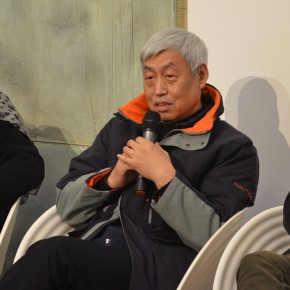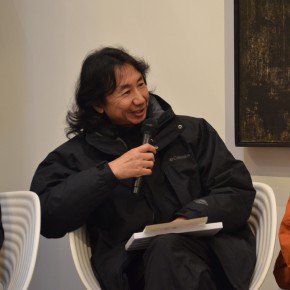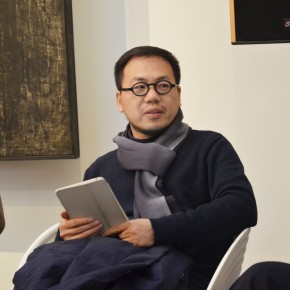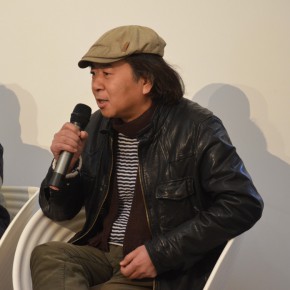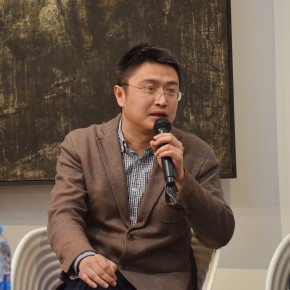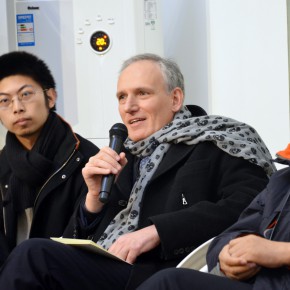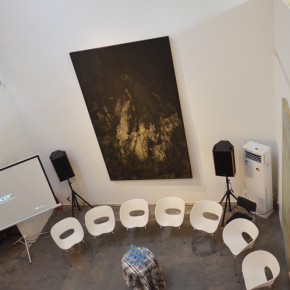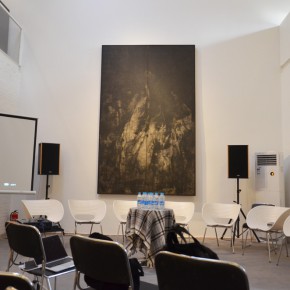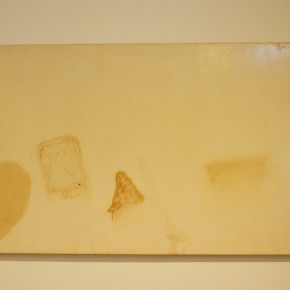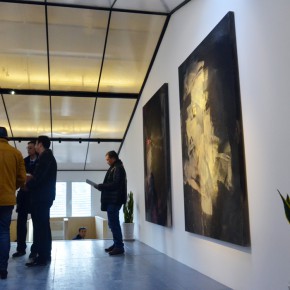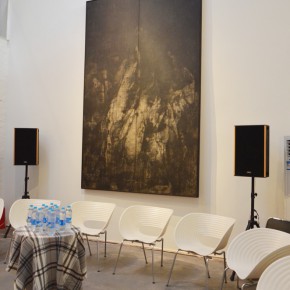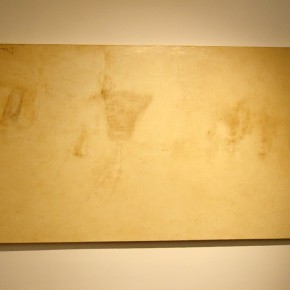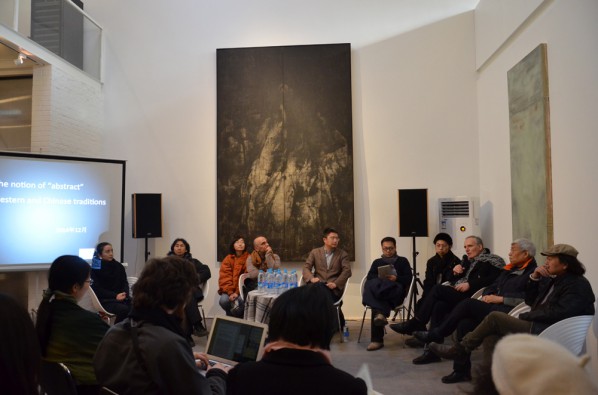
On December 20, 2014, BRIC Art Space in Beijing 798 Art District presented a panel discussion of “The Abstract in Chinese and Western Art”, to showcase the works by Shang Yang, Cao Jigang and Guan Jingjing, which is the first public event of Beijing BRIC Art Space.
BRIC Art Space comes from Italy, and the other two spaces are located in Todi and Milan. “BRICs” focuses its attention on the art coming from the BRIC countries (Brazil, Russia, India, and China). Filippo Fabrocini, Art Director of the BRIC Art Space said, the original concept of “BRICs” was related to the politics and economy, and the BRIC countries gradually revealed their unique cultural environments and aesthetic orientation, which brought a fresh breath to the civilization and history which had been dominated by Western culture.
The discussion was presided over by Filippo Fabrocini, and joined by: Prof. Darish W. Doust from Beijing Normal University, Prof. Chen Anying from Tsinghua University, Prof. Xia Kejun and Prof. Wang Jiazeng from Renmin University of China, Guo An, Director of Zhuzhong Art Museum, artists Cao Jigang and Guan Jingjing. It is entitled “The Abstract in Chinese and Western Art”, on the works of artists Shang Yang, Cao Jigang and Guan Jingjing, to discuss the concept of “abstract” in Chinese and Western art from a philosophical tradition and cultural roots.
Fabrocini defined the contemporary as the “existence and the present”, taking “The Kiss” by the female artist Tracey Rose from the Republic of South Africa as an example, to illustrate that under the background of the development of globalization, the understanding of art and culture is more complex, he said it was necessary to learn globalization on the basis of native and local cultural tradition. For the theme of the exhibition, Fabrocini said, in the “Encyclopedia Britannica”, the expression of “abstract art” has the following definition: “abstract art, also called nonobjective art or nonrepresentational art: painting, sculpture, or graphic art in which the portrayal of things from the visible world plays no part”. In this sense the expression “abstract art” is often considered equivalent to non-figurative, non-representational or non-objective art. In his view the above mentioned definition suffers from three biases: firstly, the definition suffers from a conceptual bias to the extent that, as it is obvious that even figurative and representational (or realistic) art, includes partial abstraction. Abstraction exists along a continuum. Even art that aims for verisimilitude of the highest degree can be said to be abstract, at least theoretically, since perfect representation is likely to be exceedingly elusive; secondly, the definition suffers from an historical bias to the extent that looks at Western art history as following basically a linear path leading to a progressive departure from a “realistic” representation of the reality underpinned by the logic of perspective during the Renaissance till arriving at a total independence from any reference to anything recognizable; thirdly, the definition suffers from a geographical bias deriving from a Western-centered approach characterizing most of the handbooks dealing with history of art in so far as it does not take into account art coming from countries different from Western ones.
The workshop focused on the notion of “abstract” by taking into account the works of three Chinese Contemporary artists: Shang Yang, Cao Jigang and Guan Jingjing. The expression “abstract art” is a traditional label as concerned with Western art which is the concept of “abstract” as applied to the exploration of Oriental art. Prof. Xia Kejun gave an answer, and he first analyzed the three stages of abstract art in Western art history - from geometry, to the deep emotion of the main body, and the material abstract. He pointed out that, “Shang Yang’s work is a trace of cultural memory, is the remaining ‘landscape’; in Cao Jigang’s sketch of rockery, the mottled traces are the natural traces; Guan Jingjing’s works also have some remaining traces of landscape. Western art is against nature, so it is a new cultural style devoted to China.”
However, “Abstract art” is a general term. Yet, the word “abstract” comes from the philosophical notion of “abstraction”. What is the role of the concept of “abstraction” in Chinese and Western art? Are we talking about the same concept? Prof. Chen Anying from Tsinghua University pointed out that cultural comparatives didn’t simply compare the noun, but compared it from the concept behind, the comparability located on the level of discourse structure and the conceptual system.
Barnett Newman defined painting as “a metaphysical act”. Traditional Chinese painting has been inherently and deeply metaphysical, even though in a different way from Western art. Does Chinese philosophical tradition still play a role in art? How does it play such a role? Guo An, Director of Zhuzhong Art Museum through the development and evolution of Buddhist culture in China it expounds and proves the cultural fusion. Prof. Wang Jiazeng from Renmin University of China said the greatest contribution of contemporary art was within space and perspective, creating a modern space. The Western abstraction reveals music and philosophy.
Then, Prof. Darish W. Doust from Beijing Normal University analyzed the topic “How does medium affect the output of the abstraction process?” He thought that, medium was the distinction of the expressive way of “feeling of strength”, but it was a common imagination in the medium in all arts. Finally, Artists Guan Jingjing and Cao Jigang respectively shared their experiences in their own work and the process of abstraction, and the relation with nature.
As one of the newest established art centers in the 798 Art Zone, Filippo Fabrocini, Art Director of the BRIC Art Space said, the BRIC Art Space was not a gallery, instead it aimed to provide a communication space, open to anybody interested in artistic, cultural and spiritual topics. BRIC Art Space focuses its attention on art coming from the BRIC countries, “l(fā)ooking to the local from the global but also looking to the global from the local.”
Text and photo by BRIC Art Space, translated by Chen Peihua and edited by Sue/CAFA ART INFO.


